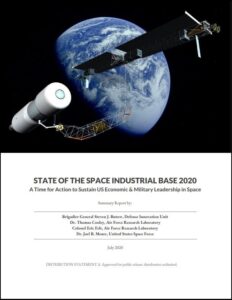 Officials within the U.S. military increasingly regard Earth-Moon space as the “high ground” in military power.
Officials within the U.S. military increasingly regard Earth-Moon space as the “high ground” in military power.
A July 2020 report based on a virtual workshop involving more than 150 thought leaders from industry, government and academia, “State of the Space Industrial Base 2020,” identifies a need to control critical “choke points” in cislunar space.
By 2060 space will be a “significant engine of national political, economic, and military power” and the United States must commit to having “a military force structure that can defend this international space order and defend US space interests, to include US space settlements and commerce.”
Lunar-derived resources — especially hydrogen and oxygen — are key to access asteroid resources and Mars. “Today’s race to the moon has little to do with flags and footprints. Strategically, it is a race to the great wealth of lunar resources which will fuel the greater space economy and enable future exploration and settlement in the solar system.”
At present the U.S is the civil, commercial and national-security leader in space. The U.S. is the first nation to demonstrate commercial orbital delivery, commercial heavy lift, commercial first-stage reusability, deployment of space-based mega-constellations for overhead sensing and internet broadband. The U.S. military maintains the most capable military constellation including the unique X-37B spaceplane.
While the U.S. has first-mover advantages, the nation faces significant challenges.
China and Russia both seek to challenge the U.S. lead, and have published ambitious roadmaps to build solar and nuclear space systems that will eclipse those of the U.S. For instance, China has targeted space-based solar power, which has the potential to dwarf today’s $400 billion satellite communications market.
The U.S. suffers from flat defense budgets, complex and opaque government procurement processes, complex legal and regulatory requirements, a low rate of Defense Department space experimentation and prototype development, shortage of STEM personnel, and lack of clarity of purpose.
“As space activities expand beyond geosynchronous orbit, the first nation to establish transportation infrastructure and logistics capabilities serving GEO [geosynchronous Earth orbit] and cislunar space will have superior ability to exercise control of cislunar space and in particular the Lagrange points and the resources of the moon,” the report says.
(Lagrange points are gravitationally stable spots between the Earth and Moon where probes can “park,” remaining in place with little fuel expenditure.)
Among other topics, the study addresses the following”
- space information services
- space transportation & logistics
- Human presence
- In-space power
- Space manufacturing & resource extraction
